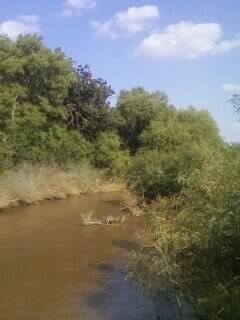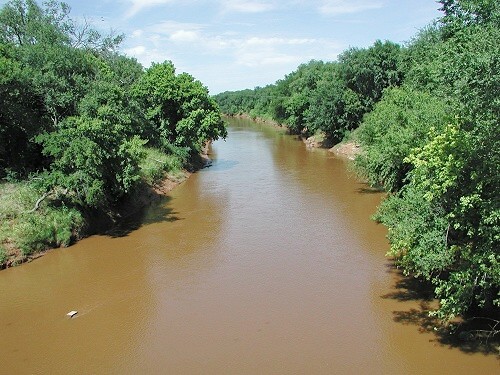|
Dead Warrior Lake
Dead Warrior Lake, sometimes known by its prior name of Dead Indian Lake, is located about 3 miles south of Roll, Oklahoma, and 11 miles north of Cheyenne in Roger Mills County, Oklahoma, on US Route 283. The lake and the adjacent Black Kettle Recreation Area are all part of the Black Kettle National Grassland, which is managed by the Cibola National Forest. The lake is about 80 acres in size. Popular species of fish caught here include flathead catfish, black drum, and blue catfish. The surroundings include amenities such as picnic tables, fireplaces, fishing piers, a boat ramp, docks, and a nature trail. Primitive camp sites are also available. Dead Warrior Creek A watercourse called at that time Dead Indian Creek was dammed in the 1950s to create the lake, and the Dead Indian Lake name followed. Early settlers in the area gave the creek that name after discovering a Cheyenne burial site. Both the creek and the lake were rechristened in June 2006 to use the "Dead Warrior ... [...More Info...] [...Related Items...] OR: [Wikipedia] [Google] [Baidu] |
Roll, Oklahoma
Roll is a community located in Roger Mills County, Oklahoma, United States. The community is on U.S. Highway 283 at the junction with State Highway 47. Cheyenne lies approximately 11 miles to the south along Route 283. The Canadian River The Canadian River is the longest tributary of the Arkansas River in the United States. It is about long, starting in Colorado and traveling through New Mexico, the Texas Panhandle, and Oklahoma. The drainage area is about .Day County, the post office was opened December 9, 1903. It closed August 31, 1920. References * Shirk, George H. ''Oklahoma Place Names''. Norman: University of Oklahoma Press, 1987. . External lin ...
|
Cheyenne, Oklahoma
Cheyenne is a town in Roger Mills County, Oklahoma, United States. The population was 801 at the 2010 census. It is the county seat of Roger Mills County. History Cheyenne is the location of the Battle of Washita River (also called Battle of the Washita; Washita Battlefield; Washita Massacre), where George Armstrong Custer's 7th U.S. Cavalry attacked the sleeping Cheyenne village of Black Kettle on the Washita River on November 26, 1868. Cheyenne has been a county seat since 1895. But construction of the nearest railroad into the area, the Clinton and Oklahoma Western Railway ("C&OW") terminated in 1912 at Strong City, and that township was laid out with a rocky knoll in the center reserved for the County Courthouse should Strong City become the county seat instead of Cheyenne. To keep their town's position, the citizens of Cheyenne responded by building the Cheyenne Short Line Railroad up the Washita River valley to Strong City to connect to the C&OW. In 1914 the courthouse ... [...More Info...] [...Related Items...] OR: [Wikipedia] [Google] [Baidu] |
Roger Mills County, Oklahoma
Roger Mills County is a county located in the western part of the U.S. state of Oklahoma. As of the 2010 census, the population was 3,647, making it the third-least populous county in Oklahoma. Its county seat is Cheyenne. The county was created in 1891. Roger Mills county is located above the petroleum-rich Panhandle-Hugoton Field, making it one of the leading sources of oil, natural gas and helium. The county also overlies part of the Ogallala Aquifer.Wilson, Linda D"Roger Mills County,'''Encyclopedia of Oklahoma History and Culture'', Oklahoma Historical Society, 2009. Accessed April 5, 2015. History Roger Mills County takes its name from Roger Q. Mills, a senator from Texas. The town of Cheyenne in Roger Mills County is the location of the Battle of Washita River (also called Battle of the Washita; Washita Battlefield and the Washita Massacre), where George Armstrong Custer’s 7th U.S. Cavalry attacked Chief Black Kettle’s Cheyenne village on the Washita River on Novem ... [...More Info...] [...Related Items...] OR: [Wikipedia] [Google] [Baidu] |
US Route 283
U.S. Route 283 is a spur of U.S. Route 83. It currently runs for 731 miles (1,175 km) from Brady, Texas at U.S. Route 87 to Lexington, Nebraska at U.S. Route 30. It passes through the states of Texas, Oklahoma, Kansas, and Nebraska. Route description Texas US 283 begins at an intersection with US 87 about three miles northwest of Brady. The highway travels through rural areas of McCulloch County before entering Coleman County. US 283 maintains its rural route through Coleman County before entering the town of Santa Anna, beginning an overlap with US 84. The two highways travel northwest together to the town of Coleman before they split. US 283 returns to a rural route once again and intersects State Highway 36 in southern Callahan County. The highway runs through the town of Baird where it crosses Interstate 20. US 283 next enters the town of Albany and shares a short overlap with US 180/ State Highway 6. Just south of Throckmorton the highway begins its lengthy over ... [...More Info...] [...Related Items...] OR: [Wikipedia] [Google] [Baidu] |
Black Kettle National Grassland
The Black Kettle National Grassland, in Roger Mills County, Oklahoma and Hemphill County, Texas, contains of which are in Oklahoma. Named for the Indian leader Black Kettle, the grassland is managed by the Cibola National Forest, which also manages the Rita Blanca National Grassland in Dallam County, Texas and Cimarron County, Oklahoma, and McClellan Creek National Grassland in Gray County, Texas. Setting The National Grassland consists of about 100 tracts of land interspaced with privately owned ranchland. It is located in the mixed grass prairie region. The terrain is characterized by sandy and red slate hills in addition to grassland and oak brush. The creek bottoms are wooded with cottonwood, elm, and hackberry. Wildlife includes white-tailed deer, turkey and quail. The Washita River flows through the grassland. It is a small stream here near its headwaters, only a few feet wide and shallow. The nearest town is Cheyenne where the Grassland headquarters is located. Hist ... [...More Info...] [...Related Items...] OR: [Wikipedia] [Google] [Baidu] |
Cibola National Forest
The Cibola National Forest (pronounced SEE-bo-lah) is a 1,633,783 acre (6,611.7 km2) United States National Forest in New Mexico, USA. The name Cibola is thought to be the original Zuni Indian name for their pueblos or tribal lands. The name was later interpreted by the Spanish to mean "buffalo." The forest is disjointed with lands spread across central and northern New Mexico, west Texas and Oklahoma. The Cibola National Forest is divided into four Ranger Districts: the Sandia, Mountainair, Mt. Taylor, and Magdalena. The Forest includes the San Mateo, Magdalena, Datil, Bear, Gallina, Manzano, Sandia, Mt. Taylor, and Zuni Mountains of west-central New Mexico. The Forest also manages four National Grasslands that stretch from northeastern New Mexico eastward into the Texas Panhandle and western Oklahoma. The Cibola National Forest and Grassland is administered by Region 3 of the United States Forest Service from offices in Albuquerque, New Mexico. Elevation ranges from 5,0 ... [...More Info...] [...Related Items...] OR: [Wikipedia] [Google] [Baidu] |
Cheyenne
The Cheyenne ( ) are an Indigenous people of the Great Plains. Their Cheyenne language belongs to the Algonquian language family. Today, the Cheyenne people are split into two federally recognized nations: the Southern Cheyenne, who are enrolled in the Cheyenne and Arapaho Tribes in Oklahoma, and the Northern Cheyenne, who are enrolled in the Northern Cheyenne Tribe of the Northern Cheyenne Indian Reservation in Montana. The Cheyenne comprise two Native American tribes, the Só'taeo'o or Só'taétaneo'o (more commonly spelled as Suhtai or Sutaio) and the Tsétsêhéstâhese (also spelled Tsitsistas, The term for the Cheyenne homeland is ''Tsiihistano''. Language The Cheyenne of Montana and Oklahoma speak the Cheyenne language, known as ''Tsêhésenêstsestôtse'' (common spelling: Tsisinstsistots). Approximately 800 people speak Cheyenne in Oklahoma. There are only a handful of vocabulary differences between the two locations. The Cheyenne alphabet contains 14 letters. Th ... [...More Info...] [...Related Items...] OR: [Wikipedia] [Google] [Baidu] |
United States Board On Geographic Names
The United States Board on Geographic Names (BGN) is a federal body operating under the United States Secretary of the Interior. The purpose of the board is to establish and maintain uniform usage of geographic names throughout the federal government of the United States. History On January 8, 1890, Thomas Corwin Mendenhall, superintendent of the US Coast and Geodetic Survey Office, wrote to 10 noted geographers "to suggest the organization of a Board made up of representatives from the different Government services interested, to which may be referred any disputed question of geographical orthography." President Benjamin Harrison signed executive order 28 on September 4, 1890, establishing the ''Board on Geographical Names''. "To this Board shall be referred all unsettled questions concerning geographic names. The decisions of the Board are to be accepted y federal departmentsas the standard authority for such matters." The board was given authority to resolve all unsettled ques ... [...More Info...] [...Related Items...] OR: [Wikipedia] [Google] [Baidu] |
Washita River
The Washita River () is a river in the states of Texas and Oklahoma in the United States. The river is long and terminates at its confluence with the Red River, which is now part of Lake Texoma () on the TexasOklahoma border. Geography The Washita River forms in eastern Roberts County, Texas (), near the town of Miami in the Texas Panhandle. The river crosses Hemphill County, Texas and enters Oklahoma in Roger Mills County. It cuts through the Oklahoma counties of Roger Mills, Custer, Washita, Caddo, Grady, Garvin, Murray, Carter, and Johnston County, Oklahoma, Johnston before emptying into Lake Texoma Lake Texoma is one of the largest reservoirs in the United States, the 12th largest US Army Corps of Engineers' (USACE) lake, and the largest in USACE Tulsa District. Lake Texoma is formed by Denison Dam on the Red River in Bryan County, Oklaho ..., which is the modern border between Bryan County, Oklahoma, Bryan County and Marshall County, Oklahoma, Marshall County ... [...More Info...] [...Related Items...] OR: [Wikipedia] [Google] [Baidu] |
Strong City, Oklahoma
Strong City is a town in Roger Mills County, Oklahoma, United States. The population was 47 at the 2010 census. History The town of Strong City was formally established June 25, 1912. It was named for Clint Strong, a railroad official and entrepreneur instrumental in the town's organization. While Cheyenne, Oklahoma was originally designated as the county seat for Roger Mills County, construction of the nearest railroad into the area, the Clinton and Oklahoma Western Railway (“C&OW”) terminated in August 1912 at Strong City. More troubling to the people of Cheyenne was the fact that Strong City had been laid out with a rocky knoll in the center, reserved for the County Courthouse should Strong City become the county seat instead of Cheyenne. Strong City also grew to become bigger than Cheyenne or any other town in the county, within a year of the railroad's arrival. To keep their town’s position, the citizens of Cheyenne responded by building the Cheyenne Short Line R ... [...More Info...] [...Related Items...] OR: [Wikipedia] [Google] [Baidu] |



